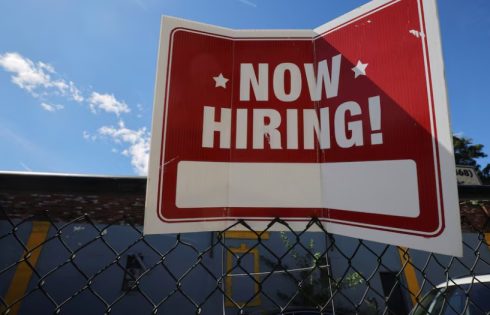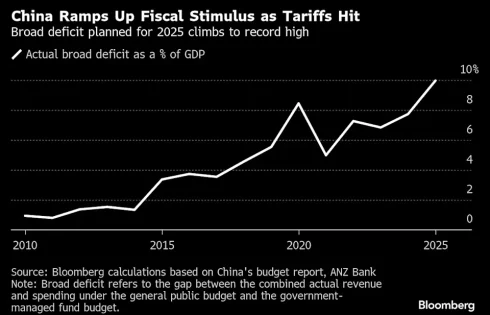China’s imports tumble as demand skids, trade war heats up




WASHINGTON, March 6 (Reuters) – The number of Americans filing new applications for unemployment benefits fell more than expected last week, suggesting that the labor market remained stable in February, though turbulence lies ahead from tariffs on imports and deep government spending cuts.
That was flagged by other data on Thursday showing layoffs announced by U.S.-based employers jumped in February to levels not seen since the last two recessions amid mass federal government job cuts, canceled contracts and fears of trade wars.




WASHINGTON, March 6 (Reuters) – The U.S. trade deficit widened to a record high in January amid front-loading of imports ahead of tariffs, suggesting that trade could be a drag on economic growth in the first quarter.
The trade gap surged 34.0% to an all-time high of $131.4 billion from a revised $98.1 billion in December, the Commerce Department’s Bureau of Economic Analysis (BEA) said on Thursday. The percentage change was the largest since March 2015.

(Bloomberg) — Asian stocks followed US equities lower as continual shifts in US President Donald Trump’s approach to tariffs on trade partners whipped up market uncertainty and dented confidence in the economic outlook.
Shares in Australia and Japan tumbled more than 1.5% each while a gauge of Chinese stocks in Hong Kong gained to the highest level since November 2021. An index of the dollar fell for a fifth session, its longest losing streak in almost a year. Bitcoin fell as details of a US strategic reserve underwhelmed.
Traders pointed to uncertainty over Trump’s tariffs. US stocks failed to stage a rebound even after a decision by Trump to delay levies on Mexican and Canadian goods covered by the North American trade deal, underscoring the fragile appetite for risk. Financial markets have whipsawed this week as investors deal with geopolitical uncertainty and conflicting signals from the US about the levies.
“Confusion reigns around the Trump Administration policy agenda,” said Chris Weston, head of research for Pepperstone Group. “While there are few signs of panic, funds and fast-money accounts cut equity risk.”
Wall Street strategists have been debating whether the Trump administration would be swayed on its tariff plans by a decline in equities. The thinking being that Trump will ditch policies if the stock market — which he touts as a report card — drops and rattles investors. Various firms even mapped out how much pain Trump could tolerate in the S&P 500 Index before retreating. That index level became known as “the Trump put,” in reference to a put option.
So far, Trump has given little indication he’ll change course. The president downplayed the reaction to the latest developments, saying “I’m not even looking at the market.” That followed his comments to Congress earlier this week that levies will cause “a little disturbance, but we’re OK with that. It won’t be much.”
Get the Markets Daily newsletter to learn what’s moving stocks, bonds, currencies and commodities
On Thursday, Trump delayed levies on goods covered by the North American trade deal from the two countries until April 2. Later comments from Treasury Secretary Scott Bessent all but confirmed tariffs will be coming. Bessent rejected the idea that tariff hikes will ignite a new wave of inflation, and suggested that the Federal Reserve ought to view them as having a one-time impact.
European stocks have advanced almost 10% this year, as rate cuts and Germany’s plan to raise defense spending boost the market. Meanwhile, a gauge of Chinese stocks listed in Hong Kong has surged almost 23% so far this year on optimism over the nation’s artificial-intelligence adoption drive and expected stimulus from Beijing.
Bitcoin fell after details of a US cryptocurrency reserve emerged and indicated the government will use digital assets forfeited as part of criminal or civil proceedings.
US equity-index futures rose Friday after US chipmaker Broadcom Inc.’s upbeat revenue forecast reassured investors that spending on artificial-intelligence computing remained ongoing, pushing its shares around 13% higher in after-market trading.
The post-hours rally spread to tech companies that were among the hardest hit on Thursday. Nvidia Corp. and Marvell Technology Inc., which plunged during the main session as its outlook disappointed investors, rose after the closing bell.
Treasuries were slightly higher Friday after a muted session on Thursday. The Mexican peso and the Canadian dollar rose on news of the potential tariff reprieve. Australian and New Zealand yields fell early Friday.
In Asia, China’s central government has ample fiscal policy tools and space to respond to possible domestic and external challenges, Finance Minister Lan Fo’an said Thursday on the sidelines of the annual legislative session. The People’s Bank of China will implement a moderately loose monetary policy, Governor Pan Gongsheng said, repeating an earlier pledge to cut interest rates and lower the reserve requirement ratio for lenders at “an appropriate time.”
China’s exports reached a record so far this year as higher US tariffs, and the threat of more to come, drove frontloading of shipments.
Upcoming US nonfarm payrolls data on Friday may help traders identify the path ahead for interest rates, as they grapple with the impact of rocky geopolitics, the impact of tariffs on global growth and the outlook for inflation.
Friday’s report from the Bureau of Labor Statistics will provide an update for Fed officials about momentum in the labor market that’s been the key support — at least until January — of household spending and the economy.
Fed Chair Jerome Powell is slated to speak at a monetary policy forum Friday afternoon. Policymakers next meet March 18-19 and they’re expected to hold interest rates steady as they gauge the labor market and inflation trends as well as recent government policy shifts.
Meanwhile, Fed Reserve Governor Christopher Waller said he wouldn’t support lowering interest rates in March, but sees room to cut two, or possibly three, times this year.
“If the labor market, everything, seems to be holding, then you can just kind of keep an eye on inflation,” Waller said Thursday at the Wall Street Journal CFO Network Summit. “If you think it’s moving back towards target, you can start lowering rates. I wouldn’t say at the next meeting, but could certainly see going forward.”
In commodities, oil was on track for the biggest weekly decline since October while gold was on track for a gain as traders sought havens.
Key events this week:
Eurozone GDP, Friday
US jobs report, Friday
Fed Chair Jerome Powell gives keynote speech at an event in New York hosted by University of Chicago Booth School of Business, Friday
Fed’s John Williams, Michelle Bowman and Adriana Kugler speak, Friday
Some of the main moves in markets:
Stocks
S&P 500 futures rose 0.3% as of 1:19 p.m. Tokyo time
Japan’s Topix fell 1.5%
Australia’s S&P/ASX 200 fell 1.8%
Hong Kong’s Hang Seng rose 0.6%
The Shanghai Composite was little changed
Euro Stoxx 50 futures fell 0.7%
Currencies
The Bloomberg Dollar Spot Index was little changed
The euro rose 0.2% to $1.0808
The Japanese yen rose 0.3% to 147.57 per dollar
The offshore yuan was little changed at 7.2443 per dollar
Cryptocurrencies
Bitcoin fell 2.9% to $87,240.54
Ether fell 2.8% to $2,150.98
Bonds
The yield on 10-year Treasuries declined three basis points to 4.25%
Japan’s 10-year yield was little changed at 1.510%
Australia’s 10-year yield declined eight basis points to 4.40%
Commodities
West Texas Intermediate crude was little changed
Spot gold fell 0.2% to $2,905.89 an ounce
This story was produced with the assistance of Bloomberg Automation.

The worst result, after buying shares in a company (assuming no leverage), would be if you lose all the money you put in. But on the bright side, you can make far more than 100% on a really good stock. For example, the Occidental Petroleum Corporation (NYSE:OXY) share price has soared 286% in the last half decade. Most would be very happy with that. On the other hand, the stock price has retraced 6.3% in the last week. But this could be related to the soft market, with stocks selling off around 1.9% in the last week.
While the stock has fallen 6.3% this week, it’s worth focusing on the longer term and seeing if the stocks historical returns have been driven by the underlying fundamentals.
There is no denying that markets are sometimes efficient, but prices do not always reflect underlying business performance. One way to examine how market sentiment has changed over time is to look at the interaction between a company’s share price and its earnings per share (EPS).
During the five years of share price growth, Occidental Petroleum moved from a loss to profitability. That kind of transition can be an inflection point that justifies a strong share price gain, just as we have seen here. Given that the company made a profit three years ago, but not five years ago, it is worth looking at the share price returns over the last three years, too. In fact, the Occidental Petroleum stock price is 21% lower in the last three years. Meanwhile, EPS is up 3.8% per year. It would appear there’s a real mismatch between the increasing EPS and the share price, which has declined -7% a year for three years.
You can see how EPS has changed over time in the image below (click on the chart to see the exact values).
Dive deeper into Occidental Petroleum’s key metrics by checking this interactive graph of Occidental Petroleum’s earnings, revenue and cash flow.
As well as measuring the share price return, investors should also consider the total shareholder return (TSR). The TSR incorporates the value of any spin-offs or discounted capital raisings, along with any dividends, based on the assumption that the dividends are reinvested. Arguably, the TSR gives a more comprehensive picture of the return generated by a stock. As it happens, Occidental Petroleum’s TSR for the last 5 years was 301%, which exceeds the share price return mentioned earlier. This is largely a result of its dividend payments!
Occidental Petroleum shareholders are down 24% for the year (even including dividends), but the market itself is up 16%. Even the share prices of good stocks drop sometimes, but we want to see improvements in the fundamental metrics of a business, before getting too interested. On the bright side, long term shareholders have made money, with a gain of 32% per year over half a decade. It could be that the recent sell-off is an opportunity, so it may be worth checking the fundamental data for signs of a long term growth trend. I find it very interesting to look at share price over the long term as a proxy for business performance. But to truly gain insight, we need to consider other information, too. Take risks, for example – Occidental Petroleum has 4 warning signs we think you should be aware of.



